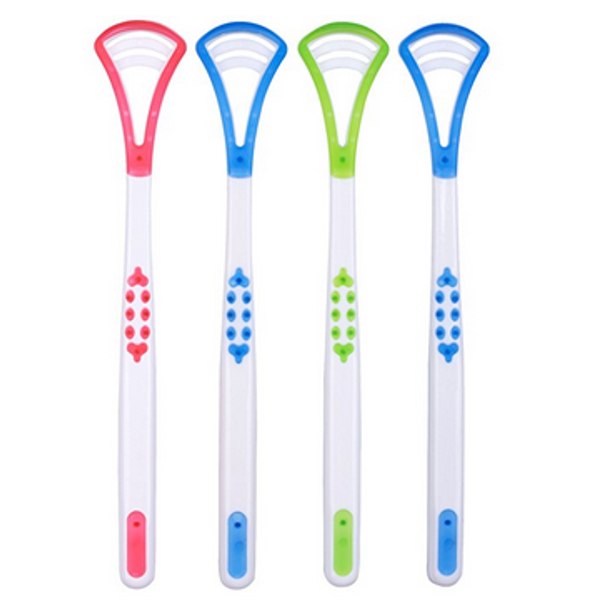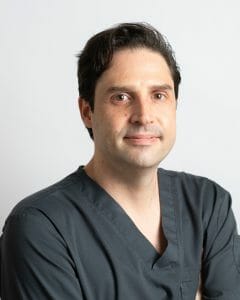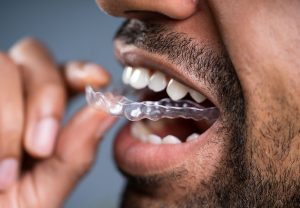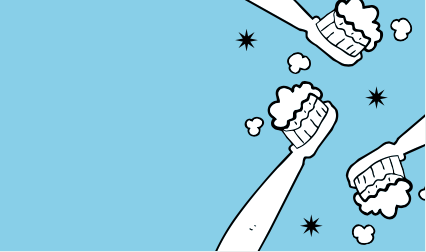
Aug 19, 2021
During your hygiene appointments, we frequently talk about your brushing and flossing routines. But, what about your tongue? It plays a critical role in your mouth and overall health. Find out why and how to keep it in shape.
The tongue is at the front line of the immune system and protects us against harmful bacteria entering our mouth when we eat and drink. Germs can travel from the mouth to other organs and cause disease, so keeping a consistent mouth cleaning routine is key not only for your teeth but for your overall health. That’s why Dr. Brunacini, Dr. Karagiorgos, and our team of wonderful hygienists recommend adding tongue scraping after brushing and flossing your teeth every day. It will only add one to two extra minutes to your routine and bring you a lot of benefits. Read on to learn more!
BENEFITS OF TONGUE SCRAPING
- Improves digestion. Your digestive process starts in the mouth and guess what happens when debris, bacteria and dead cells build up on your tongue? Saliva activation doesn’t work as well and your digestion suffers. However, when you scrape your tongue you clear out these blockages so your mouth can produce the correct amount of saliva and digestion can function properly.
- Helps prevent and reduce bad breath. In some people, the accumulation of bacteria in the mouth causes bad breath. Using a tongue scraper consistently will help remove it, and you will have a fresher breath!
- Boosts your immune system. We often talk about how a good oral health routine contributes to your overall health, and tongue scraping is a part of that. By scraping the tongue you will avoid the reabsorption of toxins, so that your immune system won’t be so busy dealing with them and will have more resources available to fight any other germs!
- Boosts up your sense of taste. When you scrape your tongue your taste buds will be freed of blockages and have direct contact with food again. Are you ready to rediscover how pepper, lemon or ginger really taste?
HOW TO SCRAPE YOUR TONGUE
Tongue scraping is easy! There is no secret to it, but there are a few details that we think are important for you to know, so that you make the most of it. Here’s the basic how-to:
- Touch the scraper to the back of your tongue with a little pressure and pull it forward. Always go from back to front. Scrape a few times until you make sure that you have covered all the surface.
- When you are done, wash the scraper with soap and keep it on a clean surface.
If you want to add tongue scraping into your cleaning routine, let us know and we are happy to give you a plastic tongue scraper to get you started! However, if you want to buy a copper scraper, that is also a good option. No matter what your choice is, know that washing your tongue with a toothbrush doesn’t work. Our hygienists are always happy to provide a demonstration, so please don’t hesitate to ask at your next appointment!
It’s easy to upgrade your daily oral health care routine with tongue scraping.Try it for a week and let us know about your experience! And as always, reach out to Dr. Brunacini or Dr. Karagiorgos with any questions or concerns. We’re your partners in oral health and here to help!
*Image courtesy of www.walmart.com
Jul 21, 2021

It’s summertime and the living is easy…except the reality is that many of our patients are dealing with increased stress and anxiety levels from the past year. This has had an impact on oral health as well, with patients reporting jaw clenching, teeth grinding, as well as cracked teeth. Fortunately, there are ways FDA can help. We talked with Dr. Karagiorgos about the impact of stress on the mouth and what treatment options are available for patients.
Have you noticed any changes in your patient’s oral health during Covid?
Dr. Karagiorgos: Most definitely. While maybe a few people started flossing and brushing more regularly as they saw themselves more on ZOOM conferences for work or family gatherings, the pandemic has had a negative impact on oral health for most patients. Tooth decay, plaque and gum disease did not stop during the pandemic. Small cavities turned into bigger cavities, big cavities turned into root canals. Some teeth that needed root canals turned into tooth extractions.
Also, people have been under a lot of stress. Stress and anxiety are bad for people’s health in general, and teeth and jaws are no exception. As a result of this increase in stress and anxiety, we are seeing a lot more clenching and grinding in patients. Some people are aware of it — they catch themselves clenching or grinding their teeth during the day — but many are clenching while they are sleeping and are not even aware they are doing it. I often ask patients if they sleep next to someone because that person might know more about their grinding or clenching habits than they themselves do.
Other questions I ask that may reveal a night grinding or clenching habit include:
- Do you wake up with sore teeth?
- Do you wake up with a sore jaw?
- Do you suffer from headaches?
- Do you suffer from neck muscle spasms?
What are your recommendations for patients who clench or grind their teeth?
Dr. Karagiorgos: The most important thing to reduce the ill effects of clenching and grinding is to recognize that it is happening. We can work with patients to develop a treatment plan, as well as help find resources and support for relaxation. For example, a warm compress on the jaw is helpful and there are exercises patients can do before bedtime to help relax their jaw.
However, since nighttime clenching and grinding is happening subconsciously, patients might continue the behavior despite their best attempts to curb it. I am a big believer in the benefits of a custom night guard; it’s an insurance policy to protect natural teeth, crowns and fillings, and especially dental implants. Like the old adage says… an ounce of prevention is worth a pound of cure. This is definitely true in teeth! I would much rather replace worn out mouth guards than have to repair damaged teeth!
What does getting a night guard entail?
Dr. Karagiorgos: It’s a simple procedure: We take a mold of a patient’s teeth and create a mouth guard specifically suited to the structure of their mouth and teeth to be worn while sleeping. We design these night guards to direct and dissipate the forces created when clenching and grinding, something that the over-the- counter versions cannot. Custom night guards also provide a much better fit than options you can find at a store, which means it will be more comfortable and less likely to dislodge while sleeping.
counter versions cannot. Custom night guards also provide a much better fit than options you can find at a store, which means it will be more comfortable and less likely to dislodge while sleeping.
That said, over-the-counter versions are a great tool to help a patient learn to sleep with a night guard. We want to know that it is something a patient can and will use before going through the process and dealing with the cost of creating a custom night guard. Night guards don’t work if they are sitting in a drawer collecting dust!
If a patient has a cracked tooth from grinding or clenching, what options do they have?
Dr. Karagiorgos: Dental bonding is the most common procedure to help smooth out or repair damaged teeth. We use a special tooth-like material that adheres quickly to teeth and can be polished and shaped to match your other teeth.
One thing to note is that a cracked tooth could be obvious or not so obvious. A piece of tooth might chip off and leave the tooth sharp to our tongue, or a cracked tooth might be completely intact but cause sensitivity to hot or cold, to biting on it, or to releasing pressure after biting. Small chips and cracks in your teeth could become larger over time, so if you have any concerns or are experiencing any of these systems, please give us a call. Dr. Brunacini and I are happy to talk to you about your concerns. We are here to help!
Thank you Dr. Karagiorgos!
If you are experiencing stress-related symptoms like a sore jaw or teeth, or have noticed a cracked tooth, please give us a call at 207.781.5900 so we can help! Our team of compassionate professionals will work with you to find a treatment plan that supports your oral health needs. Let us help you get back to that easy summertime living!

Jul 20, 2021
With Independence Day celebrations kicking off the month of July, we felt inspired by all the patriotic colors! Eating a variety of nutrient-rich foods promotes healthy gums and teeth, and incorporating a little red, white, and blue into your diet is a fun way to support your oral health! We love sharing the ways in which a healthy diet is connected to a healthy mouth! Here are some foods that will help you celebrate America and celebrate oral health.
RED
What food immediately comes to mind when you think of red and summertime? Strawberries! These juicy delights are packed with vitamin C and antioxidants which support tissue growth and repair all over your body, including your mouth. Vitamin C also helps maintain the strength and structure of the dentin in your teeth. Strawberries contain malic acid as well, which naturally whitens the teeth. Load up your morning cereal and snack to your heart’s content with these summer beauties and your teeth will thank you!
WHITE
Get yourself to the dairy aisle and stock up on some cheese, milk, and yogurt for a snack that really packs an oral health punch! Beyond calcium, which supports strong teeth and bones, these dairy products have additional benefits for your mouth. Cheese contains casein, a protein that helps fortify tooth enamel. Also, chewing cheese helps increase saliva production which washes away the cavity-causing bacteria in your mouth. Meanwhile, drinking milk can lower the acid levels in your mouth, which in turn helps prevent tooth decay. The probiotics in yogurt protect your mouth from cavities, gum disease, and even bad breath. Sounds like a win, win, win!
BLUE
We’re going a little outside of the box for this color, and diving into the deep, blue ocean. The bounty of the sea is a wonderful addition to a healthy diet. Specifically, incorporating fish that are high in vitamin D is excellent for your oral health as they aid in calcium absorption. Fish such as mackerel, sardines, and salmon are also great sources of Omega-3s which have been shown to reduce gum disease. Holy mackerel!
Do you have any favorite red, white, and blue healthy snacks to share? Give us a shout on Facebook or let us know at your next appointment! We are here to support your oral health!
Happy Summer! 🙂

Jun 23, 2021
As a general rule of thumb (rule of tooth?), the American Dental Association recommends brushing your teeth a minimum of two times a day to maintain good dental health and hygiene. You’ve probably heard Dr. Brunacini, Dr. Karagiorgos, and our team of amazing hygienists sing a similar tune at your check ups. That’s because brushing your teeth twice a day is a simple step that all of us can take to ward off plaque, bad breath, and tooth decay. But this month, let’s dig a little deeper… How often should we really be brushing our teeth and when is the best time to do it? Let’s discuss!
Q: Is brushing my teeth twice a day enough?
A: As mentioned, the ADA recommends brushing your teeth at least two times every day, with gentle strokes, for two minutes each time, and we agree! We also recommend using a fluoride toothpaste, a toothbrush with soft bristles – we particularly recommend electric toothbrushes, as well as flossing at least once per day.
Q: Should I brush my teeth before or after I eat breakfast?
A: It is always a good idea to brush your teeth in the morning due to the growth of bacteria that happens overnight. But should you brush before or after you eat and drink? Either one is fine, but if you prefer to brush after you’ve had breakfast, the ADA recommends waiting at least 60 minutes, especially if you’ve had something acidic like orange juice or coffee. This gives your saliva a chance to rinse your teeth and restore your mouth to its natural pH.
Q: Should I brush my teeth after every meal?
A: While it’s not necessary, brushing your teeth after having a high-carb or high-sugar snack is never a bad idea! Again, you should wait about an hour after eating before you brush.
Q: How often should my kids brush their teeth?
A: Two times per day is also the minimum for kids, but if your child wants to brush more, there is no reason not to, as long as he or she brushes gently and with a soft toothbrush. If your child or teen wears braces, brushing after every meal is recommended.
To make sure younger children brush their teeth for a full two minutes each time, try a toothbrush with a fun timer or teach them a two-minute song to sing or hum while brushing. You can also download a fun toothbrushing app on your phone.
Q: Does it matter when I brush my teeth in the evening?
A: Brushing right before bed each night is a great habit to get into, as it removes the bacteria that has accumulated in your mouth during the day while reducing the buildup of plaque while you sleep.
Do you have more questions about how to best care for your oral health? Give us a call at 207.781.5900 — We are your partner in oral health care and are happy to answer any and all questions you may have!
Happy Brushing! 🙂
May 26, 2021

Here’s a reason to smile… National Smile Day is May 31! National Smile Day was founded by two family dentists in Illinois to celebrate the power of a smile and draw attention to the importance of good dental health and hygiene. This is our kind of national celebration! At FDA, we love helping our patients achieve healthy and beautiful smiles. Here are 5 easy tips to take care of your smile on National Smile Day and every day!
1. Don’t rush the brush
Although it might seem like the most basic of dental tips, brushing at least twice a day is just the beginning. Brush your teeth for a minimum of 2-3 minutes each time in a gentle, circular motion with an ADA-approved toothpaste. Use a soft or extra-soft toothbrush and replace it every 3-4 months. Don’t hesitate to ask our caring team of hygienists to give you a refresher on brushing basics at your next appointment!
2. Floss like a boss
Flossing is just as important as brushing, as bacteria is most likely to form in between the teeth, which can lead to tooth decay. The ADA recommends flossing one time per day. If using traditional string floss is difficult for you to maneuver, try using a water flosser instead.
3. Rinse and repeat
After you’ve flossed and brushed, we recommend that you use an alcohol-free mouthwash to rinse away any remaining bacteria and plaque. Even if you don’t have mouthwash on hand, swishing with water is still better than nothing at all.
4. Take care of your teeth from the inside out
A diet rich in calcium, along with lots of fruits and vegetables, is good for your oral health! Eating foods that are full of essential vitamins and minerals can help to reduce inflammation and support healthy teeth and gums.
5. Schedule regular check ups with our team of compassionate dental professionals
As your partners in oral health, we want you to have the healthiest and best smile possible! Regular check ups with Dr. Brunacini and Dr. Karagiorgos are an important part of a good oral health care routine. If you have put off your routine check up due to concerns about COVID-19, or you are hesitant for any other reason, please get in touch, as we are here to help!
We hope these tips are helpful and we hope you have lots of reasons to smile this National Smile Day! If you have questions about your oral health or need to schedule your next appointment, give us a call at 207.781.5900.
*Image courtesy of www.emojipedia.org



 counter versions cannot. Custom night guards also provide a much better fit than options you can find at a store, which means it will be more comfortable and less likely to dislodge while sleeping.
counter versions cannot. Custom night guards also provide a much better fit than options you can find at a store, which means it will be more comfortable and less likely to dislodge while sleeping. 

